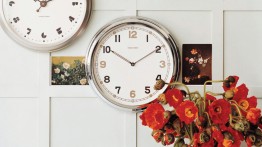Thomas O'Brien A'86

In the early 1980s, while a third-year pre-law student at Franklin & Marshall College, Thomas O’Brien took a printmaking class taught by a professor who was a Cooper Union alum. He’d been planning to follow in the footsteps of his father, uncles and brothers: after graduation, like them, he would go to work for IBM in his hometown of Endicott, PA.
But that printmaking class changed his trajectory entirely: “Everybody said, ‘What are you doing?’” he says with a laugh, recalling his decision to transfer to Cooper Union to study photography and sculpture just a dozen credits shy of graduation. “But I was thrilled by the whole idea—for me it was about both coming to Cooper Union and coming to New York City.”
Today, Thomas O’Brien is widely recognized as a leading American interior designer, home furnishing designer and taste maker. His brand of “warm Modernism” is virtually everywhere—from the homes and retail stores of Ralph Lauren and Giorgio Armani to the shelves of Target and a handful of leading home furnishing manufacturers. In 2003 he was named Designer of the Year by Elle Decor.
O’Brien’s designs, which encompass the entire spectrum of interior furnishings, convey both a traditional look and a modern sensibility to create a composite aesthetic on vivid display in the Aero store, which he founded in 1992: the juxtaposition of traditional forms and sleeker, more modern designs. It is in this open-minded approach—this mix of formality and informality, history and modernity—that O’Brien has found his milieu, making his work accessible to clients with both traditional and more contemporary tastes.
Early in his career, O’Brien worked for the likes of Mario Buatta and Ralph Lauren. Along with the interior design of apartments for Ralph Lauren and Giorgio Armani, O’Brien has worked on a wide variety of interiors over the years, ranging in scale from his own Manhattan apartment to 60 Thompson, a 12-story, 100-room boutique hotel in SoHo. Many of these projects are showcased in his book American Modern.
But it was the Vintage Modern collection for Target that made O’Brien a household name. When it debuted in 2005, it was one of the biggest launches the company had ever done, with some 500 pieces. It also made the Thomas O’Brien brand accessible at a large scale. Products include bedding, towels, carpets, dishes, lighting, furniture, stationery, and holiday decor.
O’Brien says that Target’s corporate offices reminded him of going to IBM as a child. “They have given me an enormous amount of support."
One of the keys to the line’s success—and to O’Brien’s career overall—is his comfort with combining the best of different eras. “When people ask about what I do, I might say that I help find the classic elements from past generations, and then edit them together for this one. An American idea of reinvention: traditional things for modern living.”




